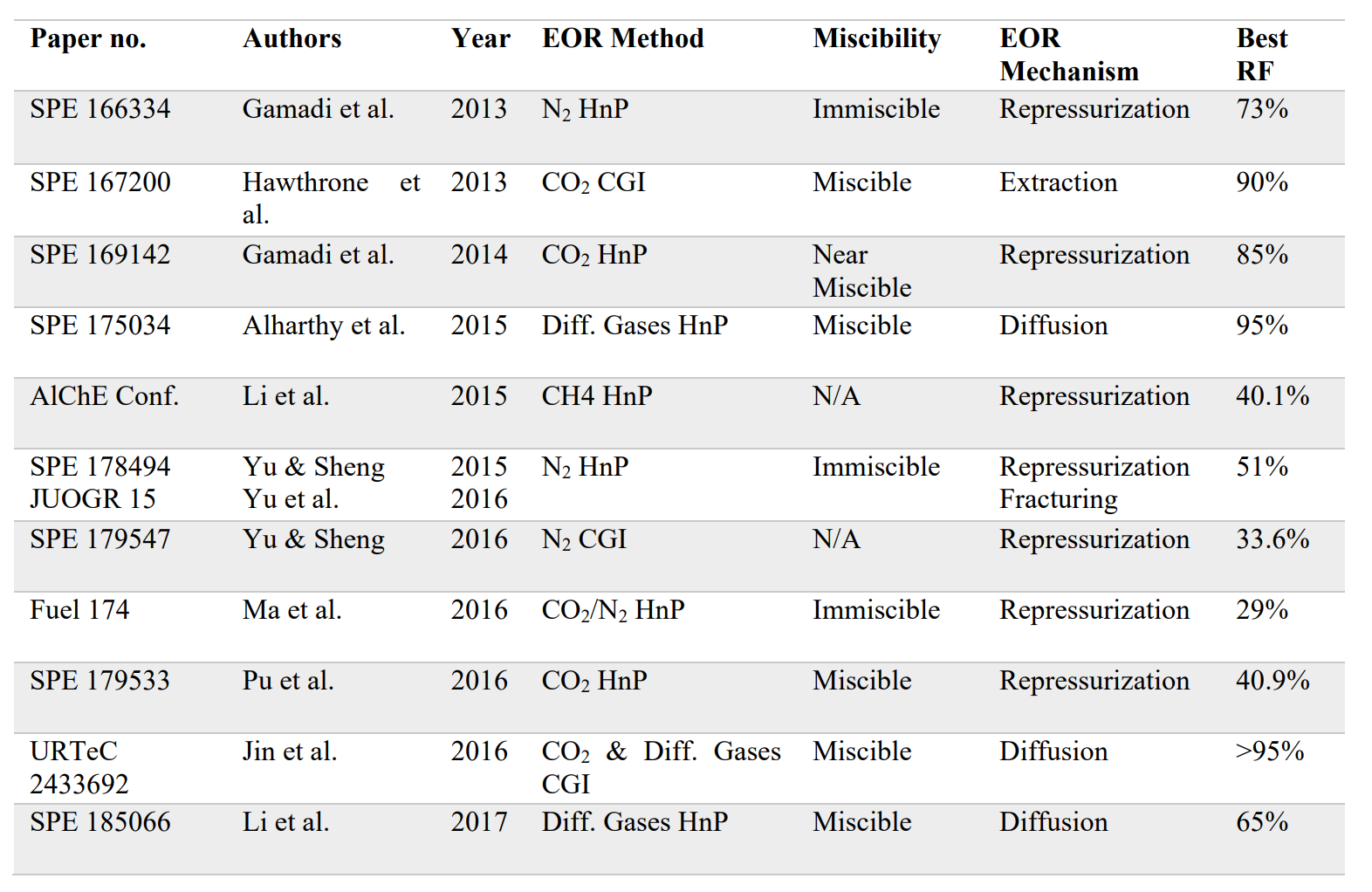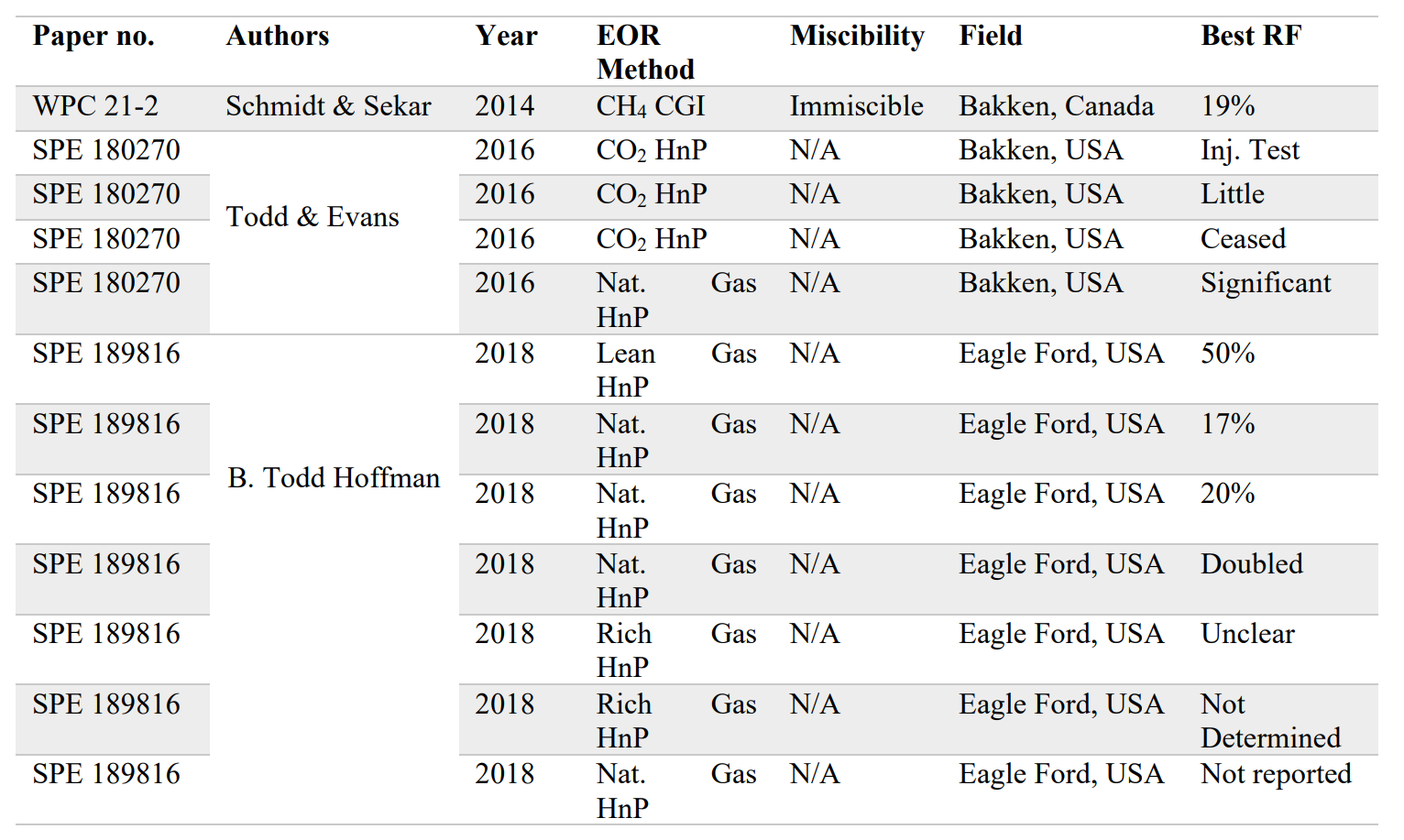Application of Gas-Assisted Gravity Drainage (GAGD) Process for Enhancing Recovery from Unconventional Resources
近十年来,水力压裂采油在非常规资源的油气生产和能源支持方面发挥了重要作用。从特征上看,这些油藏的产量递减率快,采收率低,因此需要新的提高采收率技术来弥补产量下降,并帮助维持产量。在本研究中,使用Berea砂岩(BSS)和Tuscaloosa海相页岩(TMS)中的氮气(N2)和二氧化碳(CO2)对存在裂缝的气体辅助重力泄油(GAGD)过程进行了EOR实验研究。
岩心驱油和EOR实验用于确定岩石物理性质,并研究连续注气(CGI)和GAGD等几种EOR工艺的性能。对注入方向、储层和操作条件对BSS岩心的影响进行了广泛研究。在最佳操作条件下,通过向BSS岩心注入N2和向大型BSS岩芯样品注入CO2,研究了引入裂缝和裂缝形态对提高采收率的影响。采用致密岩心塞TMS研究了低渗透(超低渗透)对提高采收率过程的影响。讨论了多孔介质中的驱油机理,以了解其对提高采收率过程的影响。
结果表明,含裂缝的N2-GAGD过程可以通过重力泄油和驱油机制有效提高非常规资源的油藏产能。CO2-GAGD通过重力、扩散、蒸发、降低原油粘度、界面张力(IFT)和毛细管力等机理显示出良好的提高采收率潜力。在BSS岩心中引入裂缝进行EOR实验通常会增加压裂改造体积(SRV)。EOR实验表明,使用CO2-GAGD工艺可从BSS裂缝中采出高达82%的地层油(OIP),而使用CO2-GA工艺可从致密(页岩)TMS岩心中采出高至7.63%的地层油。研究表明,GAGD工艺可以有效地提高非常规页岩储层中发现的低渗透率和超低渗透率裂缝性储层的采收率。
Abstract
The oil recovery with hydraulic fracturing has played an important role in hydrocarbon production and energy support last decade from unconventional resources. Characteristically, the significant production decline and low recovery factors from these reservoirs triggered the need for new EOR techniques to compensate for the decline and help sustain the production. In this study, an experimental investigation of the Gas-Assisted Gravity Drainage (GAGD) process in the presence of fractures as EOR process was conducted using Nitrogen (N2) and Carbon Dioxide (CO2) in Berea Sandstone (BSS) and Tuscaloosa Marine Shale (TMS).
Core flooding and EOR experiments were used to determine the rock petrophysical properties and investigate the performance of several EOR processes such as continuous gas injection (CGI) and GAGD. The effects of injection direction, reservoir, and operational conditions were extensively studied on BSS cores. The effect of introducing fracture and fracture configuration on EOR was investigated by injecting N2 into BSS core plugs and injecting CO2 into large BSS core samples at optimum operating conditions. The tight core plug TMS was used to study the effects of low permeability (ultra-low permeability) on the EOR process. The mechanisms of oil displacement in porous media are discussed to understand their impact on the EOR process.
The results showed that the N2-GAGD process with fractures can effectively improve the reservoir productivity from unconventional resources by gravity drainage and oil displacement mechanisms. The CO2-GAGD showed promising EOR potential through gravity force, diffusion, evaporation, and lowering oil viscosity, interfacial tension (IFT), and capillary pressure. Introducing fracture in the BSS cores for EOR experiments generally increased the stimulated reservoir volume (SRV). The EOR experiments showed that up to 82% of oil-in-place (OIP) can be recovered using the CO2-GAGD process with fractures from BSS while the oil recovery can reach up to 7.63% OIP from very tight (Shale) TMS core by CO2-GAGD process. The study showed that the GAGD process can be effective in enhancing recovery from fractured reservoirs of low and ultra-low permeabilities found in unconventional shale reservoirs.

The GAGD process improves oil recovery by accomplishing better sweep efficiency and higher microscopic displacement taking advantage of the natural tendency of fluid gravity segregation to recover the bypassed oil from unswept regions in the reservoir. Besides, the process results in delaying and minimizing water production as the horizontal production well is located at the bottom of the pay zone and above the oil-water contact level. Also, the GAGD process is cost-effective because of the usage of a single well to inject the gases in the reservoir and produce from the reservoir without the need to have multiple wells to achieve various improving oil recovery patterns, especially in the offshore and/or mature fields. GAGD process reported improving the oil recovery to ultimate level compared with the other processes experimentally and simulation modeling in conventional samples (Munawar, Rao, & Khan, 2017), (Dinh et al., 2017), (Saikia, 2016), and (Paidin, 2013). Will the process work in unconventional samples? Is it going to open a new era of improving oil recovery? Are the recoverable reserves going to be double or triple the current numbers?
To address these questions, this study aimed to examine the applicability of the GAGD process in tight and shale oil reservoirs through laboratory experiments designed to understand the mechanism of improving the recovery of unconventional resources. Different schemes were performed experimentally with different operating conditions and injected gases. The gases that have been investigated over the last decade from different studies were CO2, N2, and enriched natural gas (Alfarge et al., 2017).
Table 2. 3. Summary of the Reported Experimental Studies for Gas Injection EOR Techniques in Unconventional Reservoirs

Table 2. 4. Summary of Numerical Simulation Studies for Gas Injection EOR Techniques in Unconventional Reservoirs

Table 2. 5. Summary of Field Applications of Gas Injection Techniques in unconventional reservoirs

